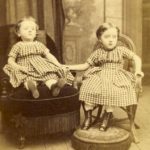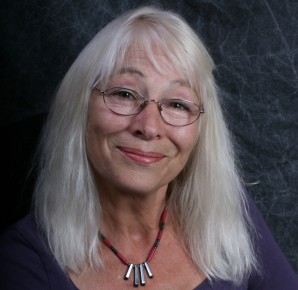 For Two Songs, one of the other stories I wrote for the long short story collection Ragman and Other Family Curses, [Egaeus Press 2016], was inspired by the photographs that were taken of dead family members in the Victorian era. Families who’d lost someone, and who could afford it, sometimes liked to have a family photograph taken with the dead one either sitting up, or propped up, or even standing so that it looked as if they were alive. If the eyes of the dead one looked a bit obviously dead, the photographer, or assistant would paint alive looking eyes onto the print. Some of these photos are so skilful that you can’t decide which is the dead person. Taking a picture in those days demanded a long exposure time during which the subject had to keep very still indeed, otherwise it would come out blurry. A couple of types of photographic stands came into use that the subject could be connected with to prevent movement — commonly the head was supported with metal bracts.
For Two Songs, one of the other stories I wrote for the long short story collection Ragman and Other Family Curses, [Egaeus Press 2016], was inspired by the photographs that were taken of dead family members in the Victorian era. Families who’d lost someone, and who could afford it, sometimes liked to have a family photograph taken with the dead one either sitting up, or propped up, or even standing so that it looked as if they were alive. If the eyes of the dead one looked a bit obviously dead, the photographer, or assistant would paint alive looking eyes onto the print. Some of these photos are so skilful that you can’t decide which is the dead person. Taking a picture in those days demanded a long exposure time during which the subject had to keep very still indeed, otherwise it would come out blurry. A couple of types of photographic stands came into use that the subject could be connected with to prevent movement — commonly the head was supported with metal bracts.
 Some people, looking at post-mortem photography, think that when they can see the often cleverly disguised metal stand, that they have located the dead family member. This is wrong; the dead don’t move, and so they wouldn’t have been blurred in the photo. The stand is for the living only. Researching in this weird and morbid area of Victorian life was pretty fascinating and I’m sure something else about their beliefs and customs should be able to trigger a story to be written. I was pleased with For Two Songs because it came together like silk and was a joy to write. I hope you enjoy it too.
Some people, looking at post-mortem photography, think that when they can see the often cleverly disguised metal stand, that they have located the dead family member. This is wrong; the dead don’t move, and so they wouldn’t have been blurred in the photo. The stand is for the living only. Researching in this weird and morbid area of Victorian life was pretty fascinating and I’m sure something else about their beliefs and customs should be able to trigger a story to be written. I was pleased with For Two Songs because it came together like silk and was a joy to write. I hope you enjoy it too.



